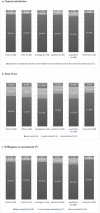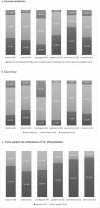Patient and clinician experience with a rapidly implemented large-scale video consultation program during COVID-19
- PMID: 33313891
- PMCID: PMC7799005
- DOI: 10.1093/intqhc/mzaa165
Patient and clinician experience with a rapidly implemented large-scale video consultation program during COVID-19
Abstract
Background: The coronavirus disease 2019 (COVID-19) pandemic has forced health-care providers to find creative ways to allow continuity of care in times of lockdown. Telemedicine enables provision of care when in-person visits are not possible. Sheba Medical Center made a rapid transition of outpatient clinics to video consultations (VC) during the first wave of COVID-19 in Israel.
Objective: Results of a survey of patient and clinician user experience with VC are reported.
Methods: Satisfaction surveys were sent by text messages to patients, clinicians who practice VC (users) and clinicians who do not practice VC (non-users). Questions referred to general satisfaction, ease of use, technical issues and medical and communication quality. Questions and scales were based on surveys used regularly in outpatient clinics of Sheba Medical Center.
Results: More than 1200 clinicians (physicians, psychologists, nurses, social workers, dietitians, speech therapists, genetic consultants and others) provided VC during the study period. Five hundred and forty patients, 162 clinicians who were users and 50 clinicians who were non-users completed the survey. High level of satisfaction was reported by 89.8% of patients and 37.7% of clinician users. Technical problems were experienced by 21% of patients and 80% of clinician users. Almost 70% of patients but only 23.5% of clinicians found the platform very simple to use. Over 90% of patients were very satisfied with clinician's courtesy, expressed a high sense of trust, thought that clinician's explanations and recommendations were clear and estimated that the clinician understood their problems and 86.5% of them would recommend VC to family and friends. Eighty-seven percent of clinician users recognize the benefit of VC for patients during the COVID-19 pandemic but only 68% supported continuation of the service after the pandemic.
Conclusion: Our study reports high levels of patient satisfaction from outpatient clinics VC during the COVID-19 pandemic. Lower levels of clinician satisfaction can mostly be attributed to technical and administrative challenges related to the newly implemented telemedicine platform. Our findings support the continued future use of VC as a means of providing patient-centered care. Future steps need to be taken to continuously improve the clinical and administrative application of telemedicine services.
Keywords: COVID-19; clinician satisfaction; outpatients; patient satisfaction; telemedicine; video consultations.
© The Author(s) 2020. Published by Oxford University Press on behalf of International Society for Quality in Health Care. All rights reserved. For permissions, please e-mail: journals.permissions@oup.com.
Figures
References
-
- World Health Organization Telemedicine: Opportunities and Developments in Member States: Report on the SecondGlobal Survey on eHealth. World Health Organization, 2010. https://apps.who.int/iris/handle/10665/44497
-
- Zimlichman E. Telemedicine: why the delay? Isr Med Assoc J 2005; 7: 525–6. - PubMed
MeSH terms
LinkOut - more resources
Full Text Sources
Medical



